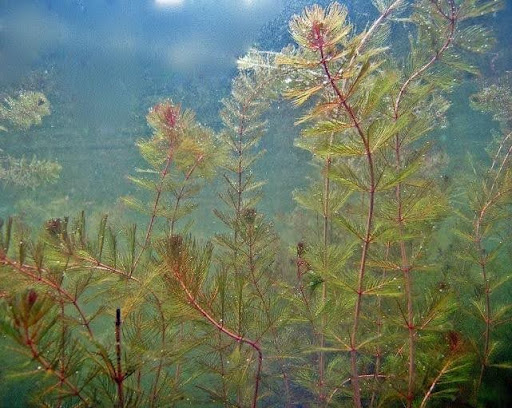Conservation Corner is a weekly article produced by the Forest County Land Conservation and Land Information Department. For more information contact Lucas O’Brien, Forest County Land Conservation Technician at 715-478-1387 or by e-mail at
Eurasian Water Milfoil
Eurasian Water Milfoil (Myriophyllum spicatum), an invasive aquatic plant, has been a significant ecological challenge in Wisconsin. Native to Europe, Asia, and Northern Africa, this species was first introduced into the U.S. in the 1880’s and made its way to Wisconsin by the 1960’s. Since then, its rapid spread has disrupted aquatic ecosystems across the state. Eurasian water milfoil is a submerged, rooted aquatic plant that thrives in freshwater environments. It’s feathery, whorled leaves form dense mats just below the waters surface, which can outcompete native vegetation. Unlike many native plants, it reproduces not only through seeds but also through fragmentation. A single stem fragment can establish a new population, making it highly efficient at colonizing new areas. The plants spread in Wisconsin is largely attributed to human activity. Boaters, anglers, and recreational water users inadvertently transport fragments of the plant on boats, trailers, and equipment. Once introduced to a new waterbody, the plant can quickly establish itself, particularly in shallow, nutrient rich waters. The spread of Eurasian water milfoil poses several threats, one of them is displacement of native plants. The dense mats formed by this invasive species block sunlight, reducing the diversity of native aquatic plants. Another threat is reduced water quality; because of the plant’s overgrowth, it can lead to oxygen depletion in waterbodies, harming fish and other aquatic organisms. A third effect is recreational hindrance, thick mats of Eurasian water milfoil can entangle boat propellers, making navigation difficult. Swimmers may also find the dense growth unpleasant or even hazardous. Last is the economic costs, managing and controlling the spread of this invasive species requires significant financial resources, often burdening local communities and conservation organizations. With these difficult threats, there have been several strategies to combat the spread of Eurasian water milfoil. The first strategy is public awareness programs like “Clean Boats, Clean Waters” educate boaters on the impact of cleaning equipment to prevent the spread of invasive species. Another strategy is mechanical removal, this technique uses mechanical harvesting machines which are used to physically remove the plant from the infested areas, though this method can be labor-intensive and costly. A third strategy is biological control which researchers are exploring the use of native weevils that feed on Eurasian water milfoil as a natural control method. The last strategy is chemical treatments, herbicides are sometimes applied to manage infestations, though their use is carefully regulated to minimize harm to native plants. As a resident or visitor in Wisconsin you can play a crucial role in preventing the spread of aquatic invasive plants. A few things you can do is inspect and clean equipment before entering or leaving a water body. Another thing you can do is drain the water from live wells, bilges, and bait buckets to prevent transfer, as well as report sightings to the Wisconsin Department of Natural Resources.

